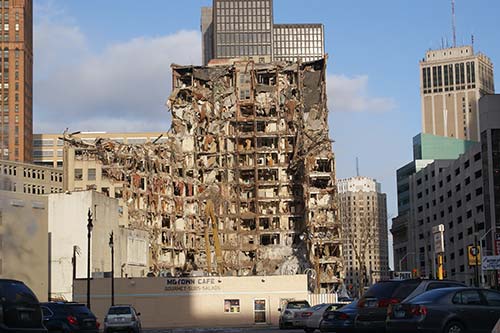

By Peter Cummings
Detroit, MI, USA

Peter Cummings
Detroit Mayor Dennis Archer knew exactly what was in the Century Box before he opened it on the stage of Orchestra Hall just before midnight December 31, 1999. A jurist and a thoughtful man, he could hardly risk opening the mysterious and dusty box in front of a crowd of 2,000 before checking things first.
A 100 years earlier, Detroit Mayor William C. Maybury had come up with the idea of the Century Box, sending requests to 56 prominent residents asking for their musings on the future of Detroit, whose population was then 285,000. The letters were placed in a metal Century Box to be opened 100 years later. As the new millennium approached, Mayor Archer made arrangements a week or two ahead to make sure that the letters had survived and to pick a few to share with the audience. The one I remember most clearly was called A Prophecy for Detroit as a Metropolis, penned by President James E. Scripps of the Evening News Association. Mr. Scripps predicted that by the year 2000 the population of Detroit would exceed 2 million.
Had James Scripps been alive in 1950, when Detroit's population peaked at 1,850,000, he would have been astounded to see his prediction on the brink of being realized 50 years ahead of schedule. Had he been around to see the city in the year 2000, he would have been even more astounded to see that the population had been cut in half from its peak and that just over 900,000 people remained inside the city limits.
How did this happen? The decline has been well documented by social observers and urban scientists during the nearly 50 years that have passed since the devastating riots of 1967. The decline had started before then: the ghettoizing influx of auto workers into the city during the first half of the century, the construction of the freeway system and simultaneous trashing of public transportation systems within the city, the suburban mall construction that in effect created new urban centers and accelerated the white flight. These factors and more conspired to hollow out the city center and to create the most segregated metropolitan area in the country. The city today remains 83 percent black.
Detroit has been much in the news of late, with stories that take a different twist. Let's start with the bankruptcy. The filing occurred in July of 2013. To many this was the pounding of the last nail in the coffin: the largest municipal bankruptcy in the history of the United States, the formal declaration that Detroit was dead. A few months earlier, Michigan Governor Rick Snyder had called in Kevyn Orr from the Washington office of Jones Day to serve as the Emergency Financial Manager. A brilliant attorney who had played a key role in resolving the bankruptcy of Chrysler in 2009, Orr pulled no punches. With the Detroit bankruptcy filing, everything was on the table, he said. The city was in debt to the tune of $18 billion and none of its assets were deemed to be safe from the grasp of creditors. That included the city-owned art collection, housed at the Detroit Institute of Arts, with a value in excess of $3 billion.

Lafayette Building, Detroit
The story of how Detroit emerged from bankruptcy, saved the art and shifted its image from perennial loser to the gritty comeback underdog is a story of the stars finally aligning for the city and of heroes hitting the long ball when singles and doubles would not have sufficed.
Heroes abounded but none were more creative or courageous than Community Foundation President Mariam Noland and US District Court Chief Judge Gerald Rosen. They realized that if the bankruptcy became drawn out and litigious, the city was doomed. They further realized that preserving the art collection without shortchanging the city pensioners was the central issue. In league with another venerated city leader, Wayne State University Board member Eugene Driker, they fashioned the so-called "grand bargain"—a plan whereby a group of foundations, the State of Michigan and patrons of the art museum came together to raise $866 million for the benefit of the city pensioners.
Talk about long-ball hitters: Ford Foundation President Darren Walker came in with a pledge of $125 million and Rip Rapson, President of the Kresge Foundation, followed with $100 million. Ten additional foundations, the State of Michigan and individual and corporate supporters of the museum produced the balance. The arrangement called for the funds to flow to the city pensioners so that they would receive close to 90 cents on the dollar of pre-bankruptcy obligations—a hugely better deal than any other course of action would have produced. The museum and its collection were simultaneous transferred from city ownership to the control of an independent non-profit entity (as is the case in most cities).
This action shifted the momentum. As the weeks and months wore on, more and more observers came to believe that the city would come out of bankruptcy on a fast track and with a minimum of rancor. December 10, 2014, only 17 months after the filing, the city emerged, facing a new era that is, at the same time, both cloudy and bright.
The following story appeared almost nine years ago in The Onion, a satirical news vehicle:
"DETROIT, April 5, 2006—Detroit, a former industrial metropolis in southeastern Michigan with a population of just under 1 million, was sold at auction Tuesday to bulk scrap dealers and smelting foundries across the United States.
'This is what's best for Detroit,' Mayor Kwame M. Kilpatrick said. 'We must act now, while we can still get a little something for it.'
Once dismantled and processed, Detroit is expected to yield nearly 14 million tons of steel, 2.85 million tons of aluminum, and approximately 837,000 tons of copper.
The decision to demolish and cull Detroit for scrap was approved last month by a 6-3 City Council vote after a cost-benefit analysis revealed that, as a functioning urban area, it held a negative cash value."
I don't want to suggest that The Onion will stop write satirical stories about Detroit. But try telling Daniel Gilbert that the city is worth little more than its scrap value. Gilbert, chairman and founder of Quicken Loans and the owner of the Cleveland Cavaliers, has emerged as the ultimate long-ball hitter in 21st Century Detroit. He has purchased in the last several years more than 60 properties in the Central Business District, many of them formerly abandoned. He has now spent close to $1.5 billion on the acquisition and refurbishment of those buildings.

Preparing the Aloft Hotel for opening in the atrium of the repurposed 100-year-old David Whitney Building (credit: Peter Cummings)
His appetite appears to be insatiable, but there is a fine method to his madness. He has moved his headquarters into the city, bringing downtown not only the Quicken employees but also the team members from a constellation of additional companies within his portfolio. Suppliers, vendors and providers of professional services must also join the migration. Want to provide legal services, marketing services, design services to Gilbert's companies? Come on downtown, lease some space and we'll give you a piece of our business. At last count Gilbert was responsible for bringing 14,000 jobs back into the city. It is literally impossible to overstate the impact he has had on the rebirth of Detroit.
Cities like Detroit simply don't come back unless and until the economic power structure and the political power structure are aligned. During the long and increasingly unhappy reign of Coleman Young, mayor from 1974 through 1994, the schism between the white business community and the black political leadership steadily widened.
Dennis Archer, Young's successor, brought dignity and integrity to the office and much progress was made during his two terms. Mayor Archer reached out to the suburbs, welcoming the involvement of the white business community in the effort to rebuild Detroit. Three casinos were approved by referendum and constructed in the city during Archer's term in office. Two new stadiums were built downtown. But in the end, casinos and stadiums don't create new residential neighborhoods. The population continued to decline. By the end of his administration, Mayor Archer was clearly drained by his experience in City Hall, and his significant contributions appeared to be little appreciated, particularly by the citizens themselves.
Kwame Kilpatrick, who followed Archer, proved to be a disappointment of titanic proportions. A talented and charismatic politician, he was elected at the age of 31. Responsibility sometimes matures people. This was not the case with Kilpatrick, whose affair with his Chief of Staff cost the city more than $8 million in settlement costs with the whistleblowers and whose pay-to-play racketeering landed him in jail for 20 years. Dave Bing, another mayor of dignity and integrity in the mold of Dennis Archer, followed Kilpatrick and restored a sense of honor and order to the Mayor's office. But his term was marred by the Great Recession and the bankruptcies of General Motors and Chrysler.

The new Shinola Dial Factory mixes design, production and retailing at its outlet in the Midtown neighborhood (credit: Peter Cummings)
By the fall of 2012, the citizenry no longer seemed to care if their mayor was black or white. They were fed up with the lack of services. Streetlights no longer functioned. Busses no longer showed up. The police took an hour to respond to calls. The voters wanted someone who could make the trains run on time and thus they elected Mike Duggan, the man who had turned around the Detroit Medical Center and with bulldog tenacity had restored the sprawling institution to profitability. Trained as a prosecutor in the Wayne County Democratic system, Duggan brings to City Hall the skills that have been lacking for two generations. He has hired smart people. The trains, so to speak, are starting to run on time.
So the stars have aligned and the city is fielding a team of long-ball hitters. Why then is the future only partly bright? Where do the clouds come from? For all the good news, the challenges that remain are herculean. The public school system continues to spiral downward. Almost one third of all property parcels within the city are owned by the city itself. Tens of thousands of abandoned and derelict structures need to be demolished. Overcoming these obstacles will require the same kind of creativity and courage that resolved the bankruptcy… and not for just 17 months, but day in and day out, for the next decade and beyond.
Shara Worden is a quirky and talented lady. She moved from New York to Detroit in 2010, attracted by the opportunity to buy a home for almost nothing, with a garden where she could plant roses and vegetables, and a neighborhood that had nowhere to go but up. "I think Detroit is a great metaphor for a lot of things," she says. "There is real hardship in the city. But there are people making things out of what they have using the resources that are available and making something beautiful and really powerful because it was created in such an adverse environment."
Shara is a singer-songwriter backed by a band called My Brightest Diamond. She is an artist who embodies the qualities of the creative class that is flocking to Detroit in droves. As she puts it: "Yep. The I-moved-to-Detroit creativity trifecta: Ex-New Yorker, fixer-upper house, and local agriculture." Her style and story come through strong in a video that she narrates entitled ALL THINGS WILL UNWIND: Stories and Sounds.

Opening of Detroit's first Whole Foods - George Jackson (Detroit Economic Growth Corporation) and Peter Cummings
Somehow, Detroit has become hip. Maybe in its own strange way it was always hip, but its hipness for many years has been overshadowed by the sense of hopelessness and despair that has only recently lifted. For too long, Detroit has been plagued by a kind of institutional inferiority complex, whereby we have devalued even the things that were clearly great. It is almost as if we were saying: "Orchestra Hall can't be great. If it were that great, it wouldn't be in Detroit."
There is only one Dan Gilbert, but there are thousands of young, creative millennials for whom Detroit is becoming a mecca. Our challenge in the city is to continue to attract them, to make sure the jobs are there, the housing is there and that a sense of security and a widening range of services will keep them there. Mayor Duggan announced after his election that he would measure his success by one key index: has the population stopped declining.
We learned on the stage of Orchestra Hall New Year's Eve of 1999 how tough it is to predict future population. That said, a lot of us are betting that this resilient city will soon start growing again.





